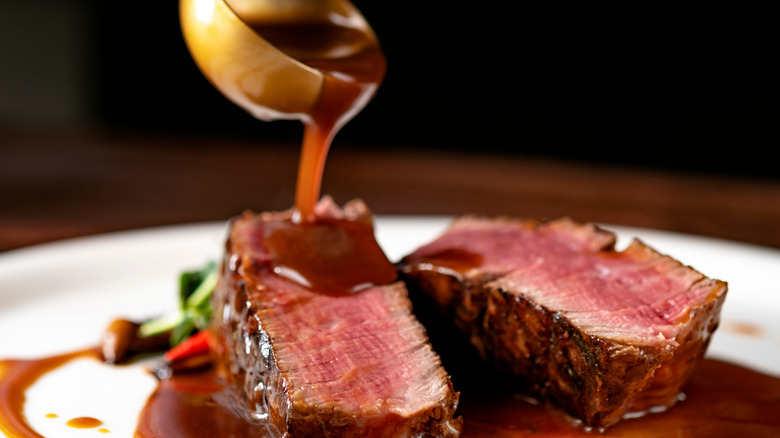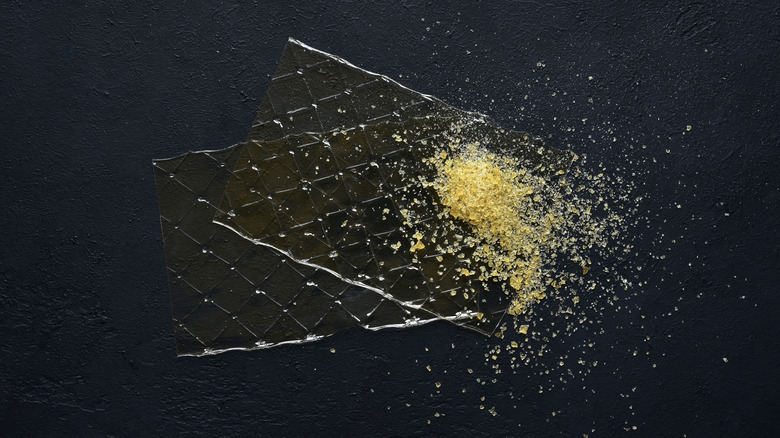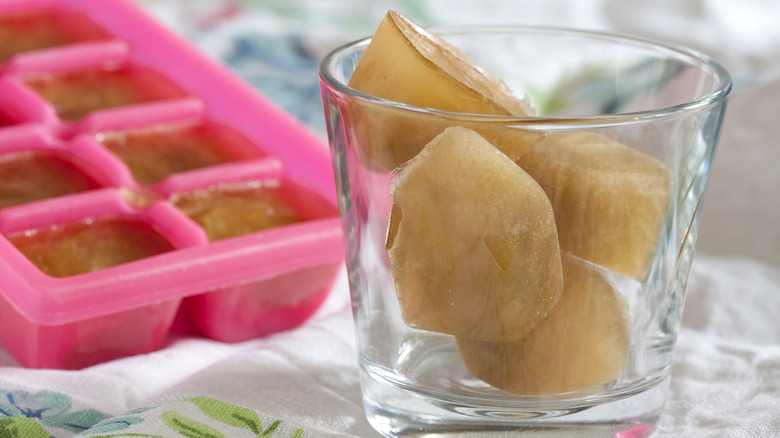Gelatin Sheets Are The Secret To Demi-Glace In A Fraction Of The Time
If you've ever watched a professional cooking show, then you've almost certainly heard 'demi-glace' (often abbreviated to just 'demi') being discussed passionately at some point. It's an iconic, ultra-rich, classically French sauce that's made primarily from roasted animal bones and stock.
A defining characteristic of demi-glace is its unique, syrupy mouthfeel. Traditionally, this comes from the gelatin that naturally forms when the collagen from animal bones — specifically veal bones, if you're sticking to Escoffier's original recipe — breaks down over hours and hours of cooking. But therein lies the rub: Demi-glace takes a long time to make, it's essentially a day's work. Once everything has reduced down, seeing the meager amount you've made for all this effort can be understandably demoralizing.
Thankfully, the miracles of modern cooking have provided us with pre-prepared gelatin. It's widely available in sheet or powder form, and you can use this to make a speedy demi-glace at home that's indistinguishable from the classic French method once it's finished. The trick is shockingly simple: Add store-bought gelatin to some boiling stock and let these reduce down together until you get a thick, glossy consistency. Voilà!
How much gelatin should you use?
Of course, in any recipe, there's always a chance things can go wrong. The main thing you'll want to watch out for when making this speedy demi-glace is getting the mouthfeel right. Reduce your stock and gelatin too much, or add too much gelatin, and you're going to end up with a gummy, thick substance that will solidify as soon as it stops being heated. Not enough gelatin, or reduce it too little, and you'll essentially still have a stock in your pot.
Conveniently, there's a ratio of stock to gelatin you can stick to that should make speedy demi-glace pretty foolproof. Use about 1 quart of store-bought, low-sodium stock (or homemade if you're feeling fancy, so long as it's not too salty) for every ¼ ounce of unflavoured, unsweetened gelatin. Then simply reduce your mixture down until it reaches approximately ⅙ of its original volume.
It's worth noting here that not all store-bought gelatins are equal. The potency of gelatin is measured in what is known as its bloom value, which varies from 30 (weakest) to 300 (strongest). Most store-bought gelatin for culinary use has a bloom strength between 200 and 250. This will usually be indicated somewhere on the packet. Thankfully, that's about the appropriate strength for using in this demi-glace trick, but it's wise to check the packet just to be sure you're not stuck with something much weaker (or stronger!).
How to store and use your demi-glace
Demi-glace is easy to pre-portion by pouring it into an ice cube tray while still hot and liquid, and then storing it in the freezer until needed. After you've pan-fried some meat, simply toss one of these cubes into the hot pan, allow it to melt, and keep heating it to allow it to thicken up until you're happy with the consistency.
While many people associate demi-glace with steak or other red meat dishes, its umami-bomb qualities make it suitable for adding depth of flavor to a wide range of dishes, from French onion soup and pot roast, to lip-smacking balsamic chicken. The original French demi-glace recipe uses veal stock, and for obvious reasons, this lends itself more to red meat dishes. However, there's no reason why you can't make alternative demi-glaces using chicken or any other animal stock.
You can even make an entirely vegan version of demi-glace using vegetable stock and swapping gelatin for a vegetable-based thickener such as xanthan gum or agar. Just make sure you check the ratio guide on any thickener product before using it, as they vary greatly in strength.


